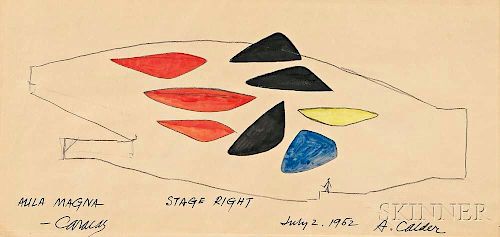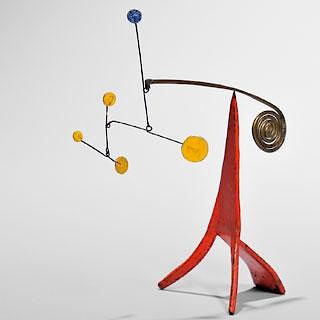Alexander Calder (American, 1898-1976) Aula Magna
Lot 438
About Seller
Bonhams Skinner
274 Cedar Hill Street
Marlborough, MA 01752
United States
Founded over four decades ago, Bonhams Skinner offers more than 60 auctions annually. Bonhams Skinner auctions reach an international audience and showcase the unique, rare, and beautiful in dozens of categories, including the fine and decorative arts, jewelry, modern design, musical instruments, sc...Read more
Categories
Estimate:
$25,000 - $35,000
Absentee vs Live bid
Two ways to bid:
- Leave a max absentee bid and the platform will bid on your behalf up to your maximum bid during the live auction.
- Bid live during the auction and your bids will be submitted real-time to the auctioneer.
Bid Increments
| Price | Bid Increment |
|---|---|
| $0 | $10 |
| $100 | $25 |
| $500 | $50 |
| $1,000 | $100 |
| $3,000 | $250 |
| $5,000 | $500 |
| $10,000 | $1,000 |
| $30,000 | $2,500 |
| $50,000 | $5,000 |
| $100,000 | $10,000 |
| $300,000 | $25,000 |
| $500,000 | $50,000 |
| $1,000,000 | $100,000 |
About Auction
By Bonhams Skinner
Jan 27, 2017 - Jan 28, 2017
Set Reminder
2017-01-27 16:00:00
2017-01-28 16:00:00
America/New_York
Bidsquare
Bidsquare : Fine Paintings & Sculpture
https://www.bidsquare.com/auctions/skinner/fine-paintings-sculpture-2062
Bonhams Skinner bidsquare@bonhamsskinner.com
Bonhams Skinner bidsquare@bonhamsskinner.com
- Lot Description
Alexander Calder (American, 1898-1976)
Aula Magna
Inscribed "AULA MAGNA/-Caracas" l.l. and "STAGE RIGHT" l.c., dated and signed "July 2, 1952/A. Calder" l.r.
Gouache, pencil, and ink on blueprint paper, sheet size 13 3/8 x 24 in. (33.8 x 61.0 cm), framed.
Condition: Toning, mat burn, tack holes to l.l. corner, handling creases, acid burn, remnants of old hinges at intervals around perimeter of the reverse.
Provenance: Gift (1952) from the artist to Robert Bradford Newman (1917-1983), professor of architectural acoustics at Massachusetts Institute of Technology School of Architecture and the Harvard Graduate School of Design, and co-founder of Bolt, Beranek and Newman Inc., Cambridge, Massachusetts; to Mary Shaw Newman in 1983; to the estate of Mary Shaw Newman.
Literature: Robert B. and Mary S. Newman Collection (Boston: J. Schwartz Design, 2014), illustrated (color) p. 11.
N.B. This work is registered in the archives of the Calder Foundation, New York, as application number A26188.
By the 1950s, Alexander Calder had become an internationally recognized and respected artist. He was chosen to represent the United States in the 1952 Venice Biennale at which he won the grand prize for sculpture. That same year, he designed sets and costumes for the play Nuclea which opened in Paris, he worked on the design for a fountain for architect Eero Saarinen's General Motors Technical Center project in Michigan, and he accepted a commission from architect Carlos Raúl Villanueva to design an acoustic ceiling for Aula Magna, the auditorium of the Universidad Central de Venezuela.
Initially, Villanueva suggested Calder create a mobile for the lobby of Aula Magna. Calder, however, preferred the idea of making something for the auditorium. Villanueva conceded, with the caveat that Calder would need to collaborate with the acoustical consulting firm, Bolt, Beranek and Newman. Calder and Robert Newman, a professor at M.I.T. and a scholar of physics, architecture and acoustics, worked together to create large round and oval shapes, some as long as thirty feet, that would serve as acoustic reflectors. Calder used the abstract forms and primary colors characteristic of his mobiles for the panels, which would hang from the ceiling and be affixed to the walls of the auditorium. Calder and Newman developed a system of steel cables and pulleys to suspend the objects from the ceiling, allowing them to be adjusted for different types of performances. As a memento of their partnership, Calder gave this study for the design of the auditorium to Newman.
The post-war building boom of the 1950s and 1960s increased the demand for public art in sites such as corporate lobbies, city plazas, and airports. Calder eagerly accepted hundreds of commissions for large-scale sculptures. His fun, light-hearted, and graceful designs coordinated well with the International Style of mid-twentieth century architecture and delighted viewers. The Aula Magna project proved successful, as both a grand art installation and a sound acoustical design.
Estimate $25,000-35,000
Hinged to window mat in three places on the top edge of the reverse with linen tape over old hinges. The paper is brittle. Toning is significant and is paler in the areas covered by the mat. Most prominent creases are to the l.r. beside and over the "A." of Calder's signature (2 1/2 in. and 1-1.2 in. crease in an X-shape that straddles the top of the initial), between "July" and "2" l.c., and to the right of "Caracas" l.l. A small 3/8 inch tear to the l.l. bottom edge which is stabilized by tape on the reverse. Subtle rippling to the sheet at u.c.
The absence of a condition statement does not imply that the lot is in perfect condition or completely free from wear and tear, imperfections or the effects of aging. Condition requests can be obtained via email (lot inquiry button) or by telephone to the appropriate gallery location (Boston/617.350.5400 or Marlborough/508.970.3000). Any condition statement given, as a courtesy to a client, is only an opinion and should not be treated as a statement of fact. Skinner Inc. shall have no responsibility for any error or omission. - Shipping Info
-
Please visit http://www.skinnerinc.com/services/payment-and-shipping/ for information regarding the collection of items purchased at auction.
-
- Buyer's Premium



 EUR
EUR CAD
CAD AUD
AUD GBP
GBP MXN
MXN HKD
HKD CNY
CNY MYR
MYR SEK
SEK SGD
SGD CHF
CHF THB
THB















